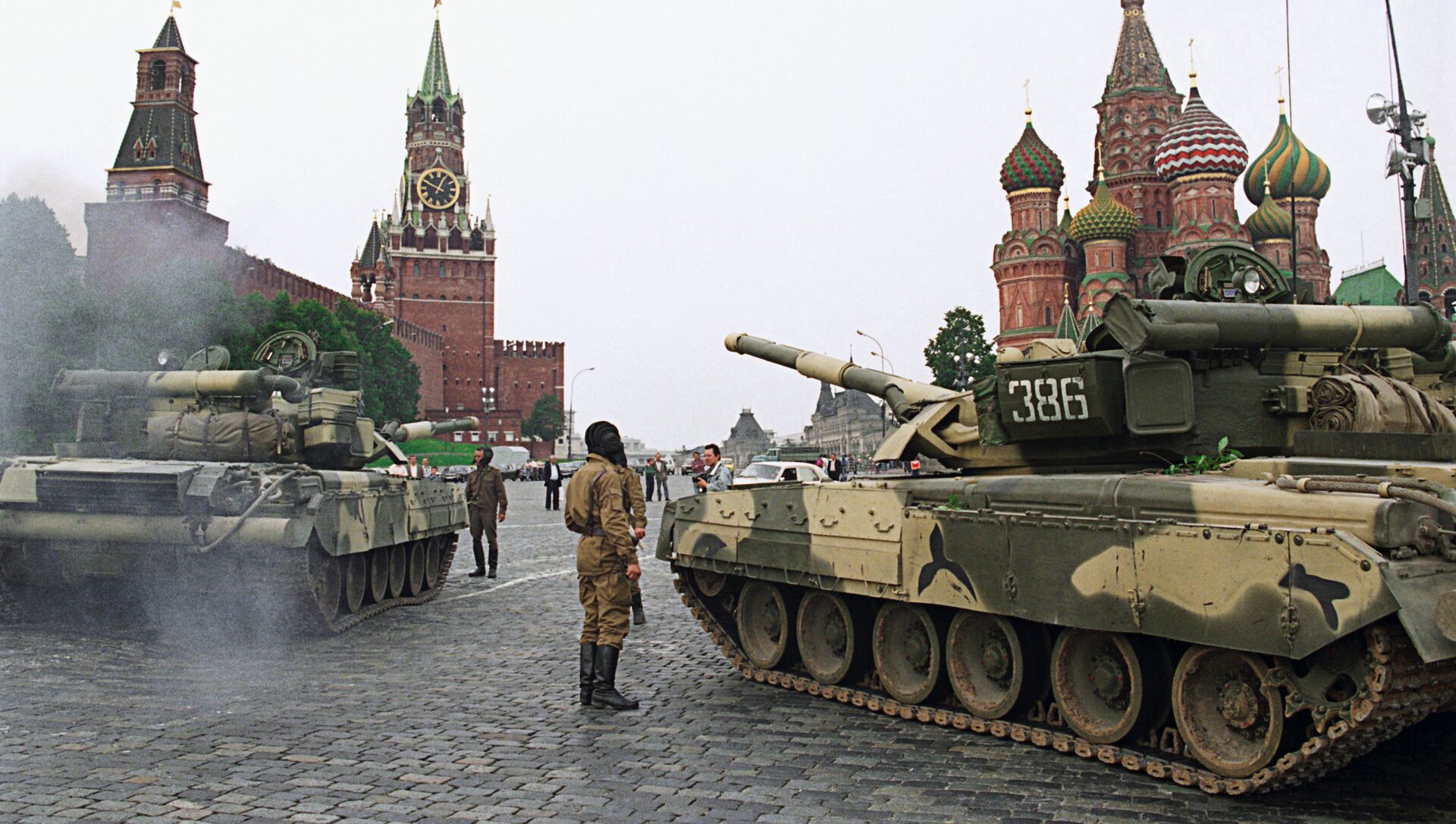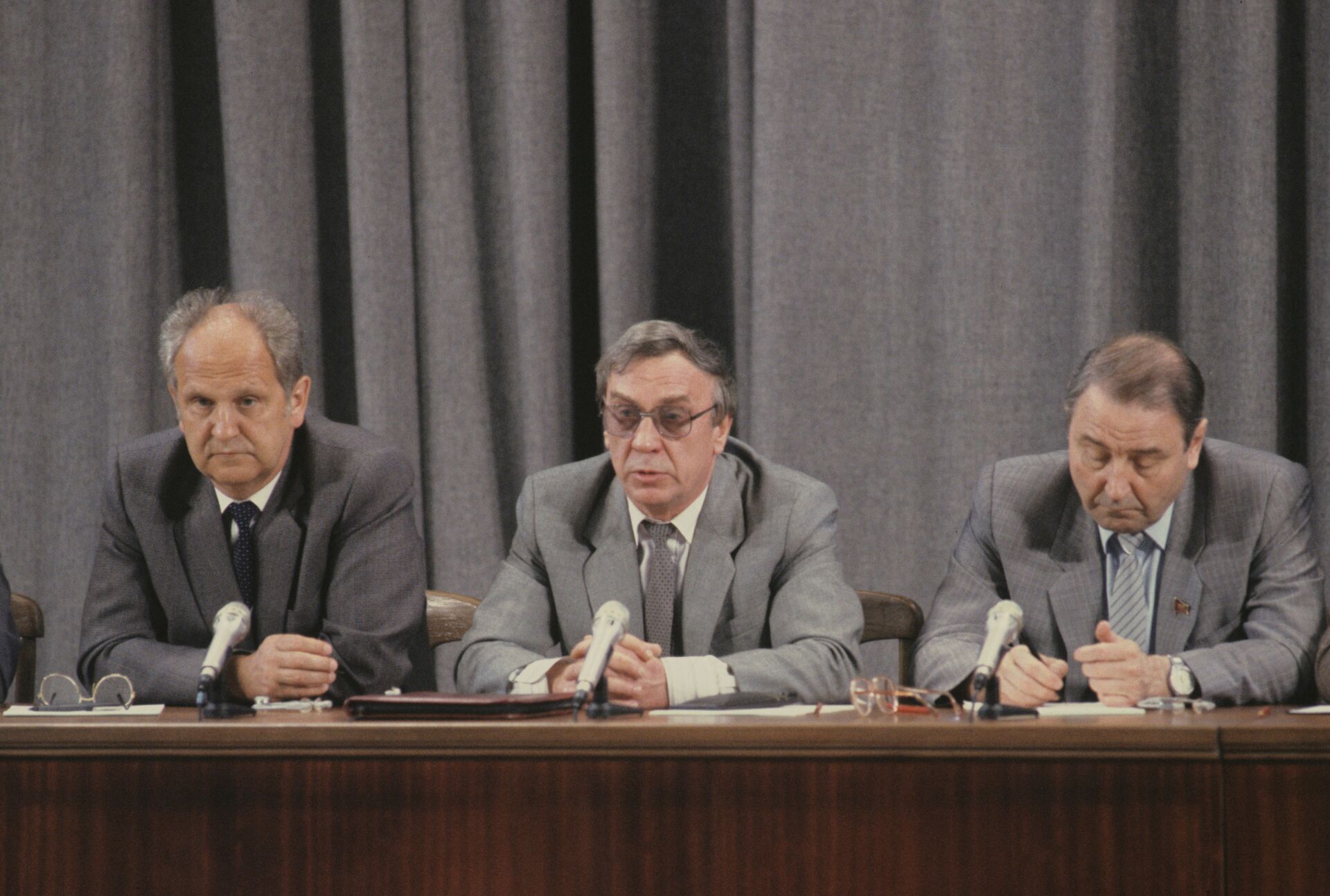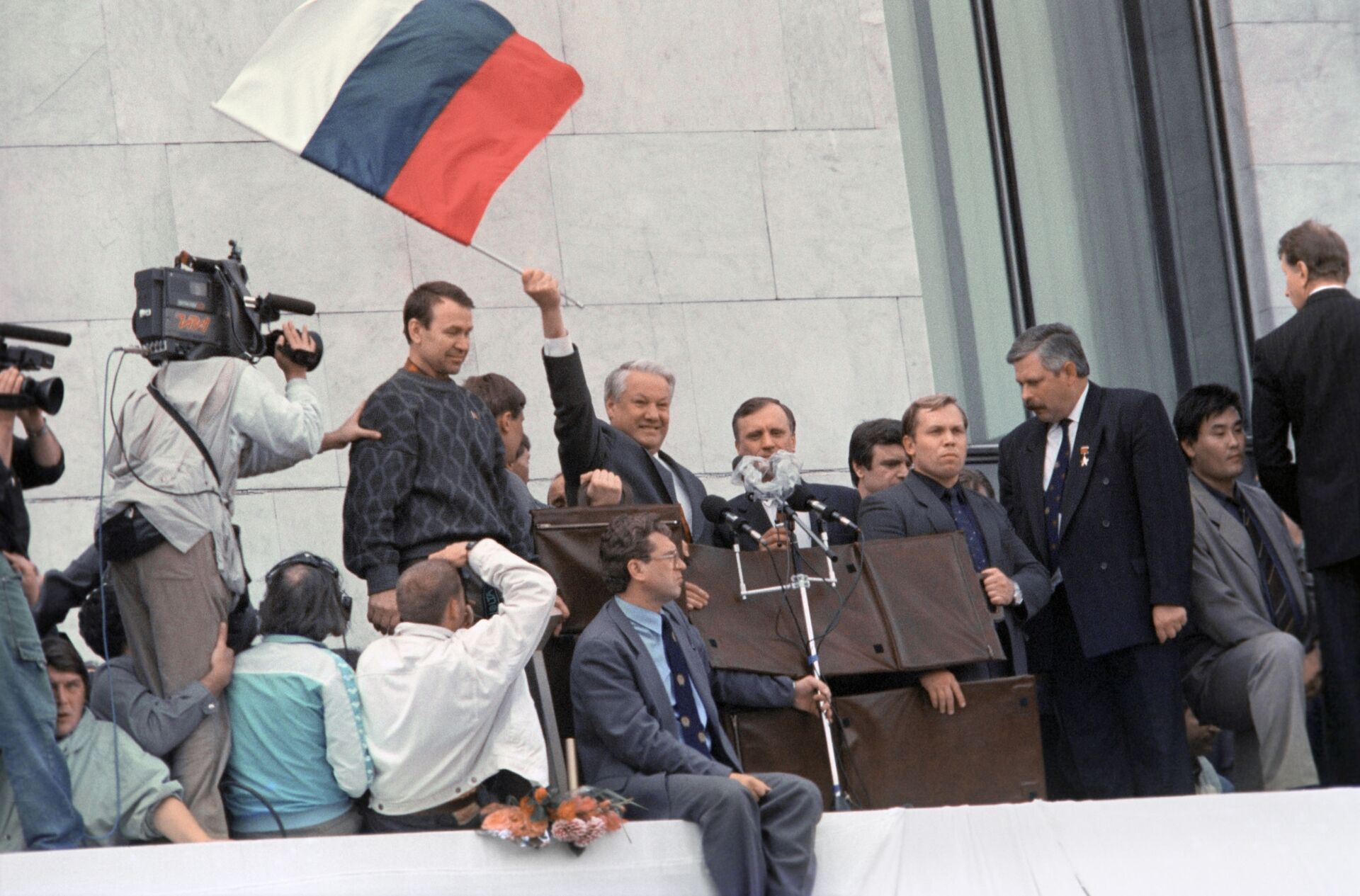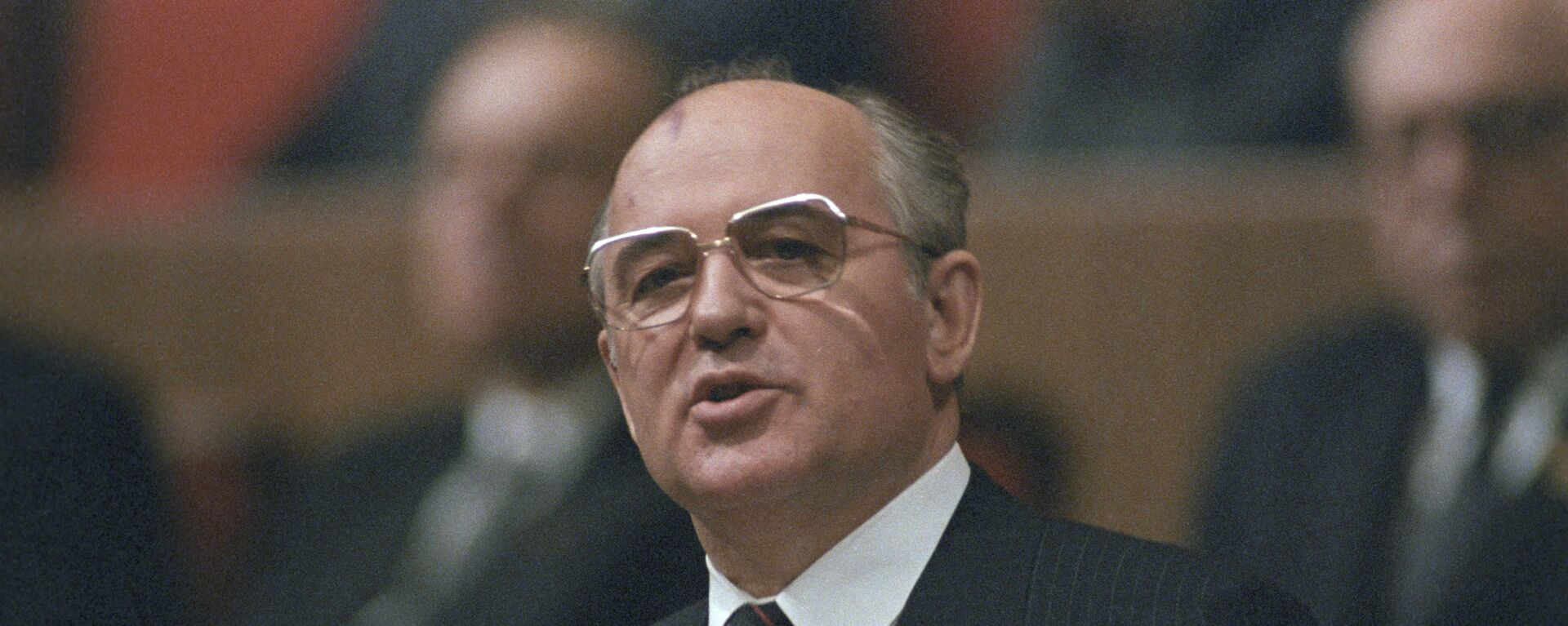Moscow Marks 30th Anniversary of Last Ditch Attempt by Communist Hardliners to Save the Soviet Union
18:57 GMT 19.08.2021 (Updated: 19:38 GMT 19.08.2021)

© RIA Novosti . Vladimir Rodionov
/ Subscribe
Shortly after midnight on 19 August 1991, Soviet vice president Gennady Yanayev signed off on the creation of the ‘State Committee for the State of Emergency’, placing Mikhail Gorbachev under house arrest in his presidential villa in Crimea and ordering a series of measures aimed at reversing his reforms.
On Thursday, Russia and other countries of the former USSR marked the 30th anniversary of the August crisis of 1991, more commonly known as the August 1991 'coup attempt', an event which sought to prevent the collapse of the Soviet Union, but ultimately ended up accelerating it.
On the night of 18 August, high-ranking officials from Gorbachev’s cabinet, including the vice president, the prime minister, and the ministers of security, the KGB and defence, created the State Committee for the State of Emergency, Russian acronym GKChP. The following morning, images of troops and tanks deployed to Moscow to ‘maintain order’ in the wake of Gorbachev’s apparent ouster spread like wildfire across the world, with Moscow’s Western partners expressing concerns that the new authorities would reverse Gorbachev’s reforms and bring an end to his pro-Western foreign policy.
In an ‘Appeal to the Soviet people’ widely broadcast on radio and television in the first hours after the state of emergency was declared, conspirators claimed that the president had become unable to perform his duties “for health reasons.”
The appeal went on to state that “in order to overcome a deep and comprehensive crisis, political, interethnic and civil confrontation, chaos and anarchy that threaten the life and safety of the citizens of the Soviet Union, as well as the sovereignty, territorial integrity, freedom and independence of our Fatherland…we declare…the introduction of a state of emergency in certain areas of the USSR for a period of 6 months from 4 am Moscow time on 19 August, 1991.”
The plotters insisted that their actions were “guided by the vital interests of the peoples of our Motherland,” the Constitution, and the then-recently passed law ‘On the Legal Regime of the State of Emergency’, as well as the results of the March 1991 referendum, in which over 76 percent of Soviets voted to preserve the country as a renewed federation.

GKChP members Boris Pugo, Gennady Yanayev and Oleg Baklanov (left to right) at a press conference on 19 August 1991.
© Sputnik / Владимир Родионов
/ The plot sprung into action amid fears that Gorbachev’s actions were leading the country toward disintegration, with severe shortages of even basic goods in shops, the retreat from Eastern Europe and the collapse of strategic trade ties, rampant inflation, crime and skyrocketing debts to international creditors eating away at the USSR’s superpower status.
In the summer of 1991, Gorbachev met with leaders of the USSR’s republics to negotiate a New Union Treaty. The negotiations were kept secret from members of the president's cabinet, and included plans to grant over two dozen additional autonomous regions of the USSR near-republic level powers which, if implemented, would have threatened to result in the country breaking up into dozens of new nations, rather than the 15 it broke up into historically. A draft copy of the treaty was leaked to the press days before it was meant to be signed on 20 August, and for the GKChP plotters, it proved to be the last straw, forcing them to act.
‘Coup Plot’
Boris Yeltsin, who was elected president of the Soviet Union’s Russian republic in June 1991, traveled to the Russian White House parliament building in Moscow on 19 August and issued his own “Appeal to the citizens of Russia,” in which he called the GKChP’s actions a “reactionary, unconstitutional coup” and called on the public to “give a worthy response to the putschists and demand that the country return to normal constitutional development.”
Tens of thousands of people poured onto the streets of Moscow to support Yeltsin, with thousands of die-hard supporters establishing encampments and makeshift barricades outside the White House using buses, trucks, building materials, trash and whatever else they could find.
Buses and barricades on Moscow’s streets: August 19, 1991
© RIA Novosti . Igor Mikhalev
/ Yeltsin issued decrees formally qualifying the GKChP as a coup attempt, and reassigned all powers held by the conspirators to himself.
Throughout the plot, Gorbachev was confined to his presidential villa in Foros, Crimea, where he had been on vacation. Gorbachev claimed to have been completely cut off from the outside world, and released a video address in which he said that he and his family’s movements had been restricted and that his ability to communicate with the outside world had been cut. However, Vyacheslav Generalov, who served as the chief of the president’s security detail during the crisis, would later reveal that although the president’s landline communications had indeed been cut, the secure connection from his Zil limousine was still working and that Gorbachev could have contacted anyone he wanted to by phone, but categorically refused to do so.
Shot from USSR President Mikhail Gorbachev's video address to people of his country. 1991 August Coup
© RIA Novosti . Yuryi Abramochkin
/ The GKChP collapsed in the early hours of 21 August not with a bang, but with a whimper, with KGB chief Vladimir Kryuchkov and Defence Minister Dmitry Yazov, for reasons which remain unclear to this day, refusing to give the order to arrest Yeltsin, to make any attempts to block his movements, or storm the White House where he and senior supporters were holed up.
Sergei Stepashin, the former Russian prime minister who ran the state commission investigating the activities of the GKChP after its collapse, has speculated that the GKChP planned to replace Gorbachev with Yeltsin as head of the USSR. Former Yeltsin bodyguard Alexander Korzhakov has confirmed in interviews that Yeltsin met with Kryuchkov on 17 August 1991 for talks, and that the KGB chief had asked him to “take care of Boris Nikolayevich” as they were leaving the KGB building.
After the GKChP’s disintegration, the Soviet Communist Party was banned, Gorbachev was returned to Moscow with his powers significantly weakened, and several months later, on 8 December of 1991, the leaders of the Russian, Ukrainian and Belarusian republics met at a dacha in the Belovezhskaya Puscha forest in western Belarus to formally declare the USSR defunct. Gorbachev initially dismissed this declaration as unconstitutional, but eventually caved and resigned on 25 December, with the Soviet of the Republics (the upper chamber of the Supreme Soviet) meeting on 26 December to formally vote the country, and itself, out of existence.
Gorbachev has repeatedly blamed the GKChP conspirators for the USSR’s collapse. In 2019, he told German news magazine Der Spiegel that “those who organized the coup in August 1991, and who took advantage of the weakened position of the president of the USSR, are responsible for the end of perestroika and the collapse of the Soviet Union.”
However, Alexander Rutskoy, the former vice president of Russia who served as Yeltsin’s right hand during the events of August 1991, categorically rejects classifying the events as a coup or putsch attempt.
“I would like to emphasize once again that this was not a putsch, but an attempt, made with mistakes, to save the Soviet Union. And over the years my attitude toward these events has not changed. And how can it, if I am a living witness of the truth of what happened?…This was the introduction of a emergency management of the country. A decision on [introducing a state of emergency] was made by Gorbachev all the way back in March of 1991. And this took place in August,” Rutskoy told Sputnik.

Russian Soviet Federative Socialist Republic President Boris Yeltsin waves a Russian tricolour during a meeting in front of the Russian White House in Moscow, August 1991. Vice President Alexander Rutskoy standing third from the right.
© Sputnik / Игорь Михалев
/ According to Rutskoy, the GKChP’s biggest mistake was sending troops to Moscow. “This shouldn’t have been done. And afterwards distorted information had been released that Gorbachev had been arrested. I brought Gorbachev [back to Moscow] from Foros, and I stopped this whole process, not the ‘great commander’ Yeltsin,” the politician said. Rutskoy suggested that Gorbachev’s claims that he was “arrested” were something the president “invented himself.”
After the plot collapsed, all of the senior-most GKChP conspirators were stripped of their posts and sent to prison, apart from Interior Minister Boris Pugo, who took his own life shortly beforehand. Ten others were jailed and put on trial for high treason, before being amnestied by the Russian Duma in 1994. None have publicly expressed regret for their actions. Oleg Baklanov, the former minister responsible for defence issues and the Buran space shuttle programme, was the last of the GKChP plot leaders to pass away, dying at age 89 on 29 July, 2021. In his memoirs, Baklanov emphasized that his “conscious [was] clear,” and that he remained convinced that the GKChP was “morally and historically” in the right.


